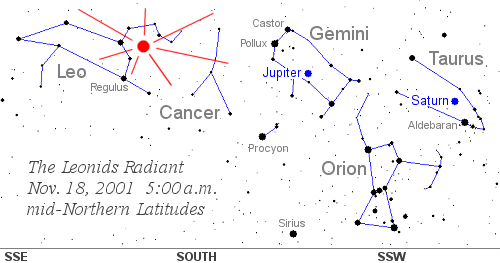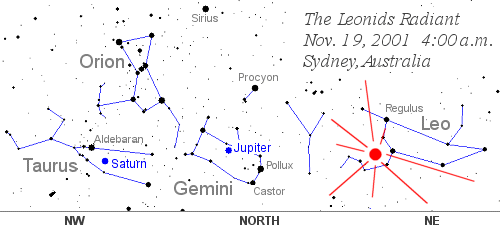|
back to spaceweather.com The 2001 Leonid meteor shower, perhaps the biggest in decades, is coming soon. If you live in North America or Hawaii, you should be alert for meteor outbursts between midnight and dawn on Sunday morning, Nov. 18th. If you live in Australia or one of the many Asian countries along the Pacific Rim, the right time to be outdoors is Monday morning, Nov. 19th. Visit these sites for more information:
Leonid meteors will appear to stream from a point (called the radiant) in Leo the Lion. The constellation is easy to spot: it has a characteristic question-mark shape punctuated by the bright star Regulus. Look for it rising above your eastern horizon between local midnight and 1:00 a.m.  Above: The southern sky as viewed from mid-northern latitudes on the date of the 2001 Leonid meteor shower. The Leonid radiant is denoted by a red dot. The Leonid radiant will climb higher as the night unfolds, reaching a maximum altitude of about 65 degrees at mid-northern latitudes, but only 30 degrees in, say, southern Australia. Because the radiant lies higher in northern skies, the northern hemisphere is generally a better place to spot Leonids. However, this year an predicted outburst over Australia could compensate for the low-hanging radiant and produce a dazzling show there. Staring directly toward the radiant is not necessarily the best way to enjoy the shower. Leonids that appear there will seem short and stubby -- a result of foreshortening. Instead, look toward any dark region of the sky 45 to 60 degrees away. You'll see just as many Leonids, but they will seem longer and more dramatic. The tails of all Leonid meteors, no matter where they appear, will point back toward the radiant in Leo.  Above: The northern sky as viewed from Sydney, Australia, on the date of the 2001 Leonid meteor shower. The Leonid radiant is denoted by a red dot. And finally, Earthgrazers: if you begin observing before Leo rises -- that is, around local midnight -- and a Leonid meteor outburst occurs, then you may spot a flurry of shooting stars called Earthgrazers. These are disintegrating meteoroids that fly over the horizon nearly parallel to the atmosphere. They produce long colorful tails. Usually Earthgrazers are remarkably slow-moving, but Leonid meteoroids are the fastest known. They strike Earth's atmosphere traveling 72 km/s (161,000 mph!) and so appear to streak very quickly across the sky. Even the Earthgrazing variety of Leonid meteors may appear fast-moving. Clear skies and good meteor hunting! |